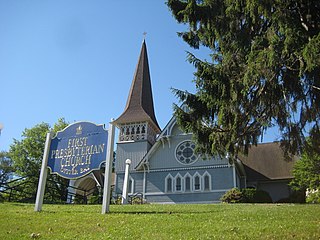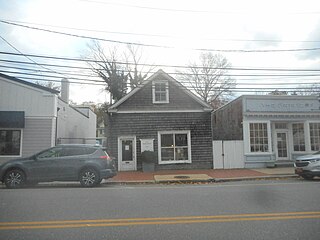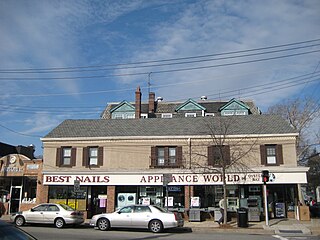
Oyster Bay is a hamlet and census-designated place (CDP) on the North Shore of Long Island in Nassau County in the state of New York, United States. The hamlet is also the site of a station on the Oyster Bay Branch of the Long Island Rail Road and the eastern termination point of that branch of the railroad.

Sagamore Hill was the home of the 26th president of the United States, Theodore Roosevelt, from 1885 until his death in 1919. It is located in Cove Neck, New York, near Oyster Bay on the North Shore of Long Island, 25 miles (40 km) east of Manhattan. It is now the Sagamore Hill National Historic Site, which includes the Theodore Roosevelt Museum in a later building on the grounds.

The Eisenhower Executive Office Building (EEOB), formerly known as the Old Executive Office Building (OEOB), and originally known as the State, War, and Navy Building, is a United States government building that is part of the White House compound in the U.S. capital of Washington, D.C. Maintained by the General Services Administration, the building currently houses the Executive Office of the President, including the Office of the Vice President of the United States. In 1999, the building was renamed in honor of Dwight D. Eisenhower, the 34th U.S. president and a five-star U.S. Army general who oversaw several military campaigns of the Allied forces during World War II.

Ethel Carow Derby was the youngest daughter and fourth child of the President of the United States Theodore Roosevelt. Known as "The Queen" or "The First Lady of Oyster Bay" by its Long Island residents, Ethel was instrumental in preserving both the legacy of her father as well as the family home, "Sagamore Hill" for future generations, especially after the death of her mother, Edith, in 1948.
The Theodore Roosevelt Association (TRA) is a historical and cultural organization dedicated to honoring the life and work of Theodore Roosevelt (1858–1919), the 26th President of the United States.

Oyster Bay is the terminus on the Oyster Bay Branch of the Long Island Rail Road. The station is located off Shore Avenue between Maxwell and Larabee Avenues. It is a sheltered concrete elevated platform that stands in the shadows of the original station, which was accessible from the ends of Maxwell, Audrey, and Hamilton Avenues. Both stations exist along the south side of Roosevelt Park.

The Oyster Bay Post Office in Oyster Bay, New York was completed in 1936. New York architect William Bottomley designed this colonial revival structure to mirror the Oyster Bay Town Hall across the street. Inside are murals by the prominent American artist, illustrator and author Ernest Peixotto, depicting scenes in Oyster Bay from 1653 to 1936 when the Post Office was built. This building is listed on the National Register of Historic Places and featured on the Oyster Bay History Walk.

First Presbyterian Church built in 1873 is classified as an historic Stick/Eastlake style Presbyterian Church building located at 60 East Main Street in Oyster Bay, in the U.S. state of New York. Its architect was J. Cleaveland Cady, who was just beginning his career and would go on to design the original Metropolitan Opera House, the American Museum of Natural History, buildings at Yale University, Trinity College, and 23 other churches including the Plantsville Congregational Church, Southington, CT in the similar Gothic Revival style.

The Octagon Hotel, built as the Nassau House by Luther Jackson in 1851, was a pre-eminent political and social meeting space in Oyster Bay, New York. This eight-sided building is also believed to be among only a few like it on Long Island and perhaps the only octagon-shaped hotel in the United States.

Snouder's Drug Store was the oldest operating business in Oyster Bay, New York. The store was first established in 1884. The first telephone in Oyster Bay was installed here, and for several years it remained the only one in town. When Theodore Roosevelt became Governor of New York State and later President, the press corps gathered at Snouder's to transmit news from Oyster Bay. Phone service and the soda fountain installed in 1889 made Snouder's one of the most popular gathering places in town. In the 1990s the exterior was returned to its original color, which was determined through paint chip analysis. The building is a Town of Oyster Bay Landmark and was a featured site on the Oyster Bay History Walk audio walking tour.

Theodore Roosevelt Memorial Park is a park in the hamlet of Oyster Bay, New York, honoring President Theodore Roosevelt, 26th President of the United States.
Theodore Roosevelt spent his first summer in Oyster Bay with his family in 1874. Through the ensuing years as he rose to power, Oyster Bay would frequently serve as backdrop and stage on which many of his ambitions were realized. Several places connected to Theodore Roosevelt in his lifetime remain, while others have been lost. A number of efforts to memorialize Roosevelt in Oyster Bay have been made since his death in 1919.

Christ Church, founded in 1705, is a historic Episcopal parish located at 61 East Main Street in Oyster Bay, New York. Several church buildings have occupied this site, including one that served as soldiers' barracks during the Revolutionary War.
Youngs Memorial Cemetery is a small cemetery in the village of Oyster Bay Cove, New York in the United States of America. It is located approximately one and a half miles south of Sagamore Hill National Historic Site. The cemetery was chartered in 1900 and was located on land owned by the Youngs family.
The Oyster Bay History Walk is a path through downtown Oyster Bay, New York that leads the walker to 30 historic sites. It is a 1-mile loop and is the first certified American Heart Association Start! Walking Path on Long Island.

Fleet's Hall is a building that once stood in Oyster Bay, New York, that had important local, statewide, and national significance. The building served as an important civic and social meeting place during the time that Theodore Roosevelt was a resident of Oyster Bay and served as Governor of New York State and later President of the United States. The building was used for events such as public meetings, concerts, receptions, dances, and dinners. It was also the site of the first moving picture screening in Oyster Bay.

The Oyster Bay Bank Building was constructed in 1891 and served as the first bank in Oyster Bay on Long Island, New York. In addition to the bank, other users have included the Masons of Matinecock Lodge, Theodore Roosevelt while he served as Governor of New York, and architect Edward Durrell Stone. Today this building is a featured site on the Oyster Bay History Walk audio walking tour.
Wightman Memorial Baptist Church in Oyster Bay, New York, was first built in 1908. It is the third building on this site. The first Baptist congregation met in Oyster Bay as early as 1700, and Oyster Bay received its first ordained minister in 1724. The second church building, constructed in 1806 is still visible on the site, behind the newer structure.

The Oyster Bay Guardian is a weekly newspaper published in Oyster Bay, New York, since 1899. Back then, Nelson Disbrow began publishing this paper and also got a building to house his operations on West Main Street. While the newspaper has moved to another building, their building on West Main Street remains. Today, this building houses a commercial printing operation. The house is now a Town of Oyster Bay Landmark and a featured site on the Oyster Bay History Walk audio walking tour.

The Ludlam Building is a Greek Revival styled building, located in Oyster Bay, New York. Past occupants include a dry goods store, a grocery store, and a haberdashery. Despite a number of fires, the brick shell of the building remains.



















